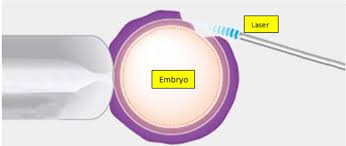Laser-assisted hatching uses a precise laser to create a small opening in the embryo’s zona pellucida (outer shell) to aid hatching and implantation.
When It’s Used
Women over 38 with thicker zona pellucida.
Patients with repeated implantation failures.
Embryos with thickened or abnormal zonae, often due to freezing or culture conditions.
Procedure
Performed in the lab just before embryo transfer.
A low-energy laser creates a controlled opening, ensuring embryo safety.

Benefits
May improve implantation rates in specific cases.
Safe and quick, with no impact on embryo viability.
Risks
Limited evidence for universal benefit; the American Society for Reproductive Medicine (ASRM) suggests it’s not necessary for all patients.
Minimal risk of embryo damage if not performed by experienced embryologists.

